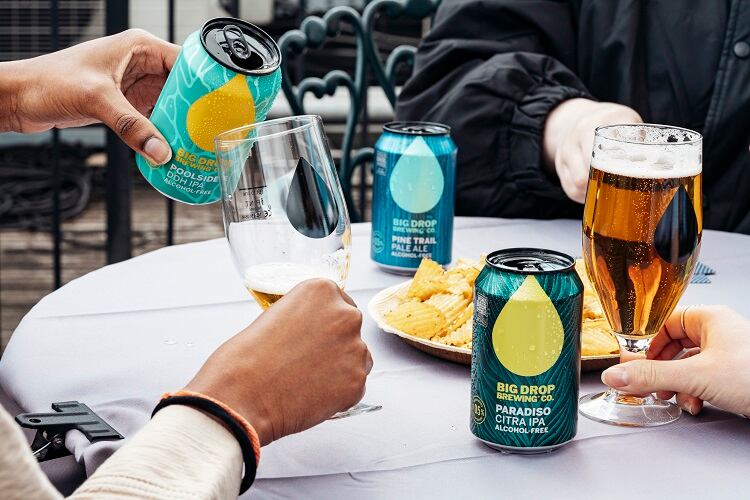The craft beer sector has been booming since the early 2000s. Before the coronavirus pandemic hit, the market was on a steep upwards trajectory, with Kantar Worldpanel data indicating a 16.4% growth to £178.2m in 2019.
The proliferation of craft breweries throughout this time saw the likes of BrewDog and Camden Town enter the UK scene. However, during the ‘craft beer revolution’, Rob Fink recalled that ‘none of them were doing alcohol-free’.
Having decided to abstain from alcohol for the first six months of his son’s life, Fink became quickly frustrated at the lack of choice in alcohol-free on offer. “I don’t want to go to the pub and drink orange juice or [soft drink],” he told this publication at the recent Low2NoBev event in London. “I like craft beer.”
Quickly, the overarching question became: “What if we could do for alcohol-free beer, what craft beer did for beer?”
In 2016, Fink founded Big Drop Brewing Co with co-founder James Kindred to combine these two trends. Today, the brand’s range spans from pale ale to stout, IPA, American pale ale, and sour beer.
“To the best of my knowledge, we were the first company to dedicate itself to alcohol-free beer,” the CEO said. “It’s about providing consumers options and choice.”
The science behind the beer
Marketed as ‘alcohol-free’, Big Drop beer has an ABV of 0.5%. Its brewing method differs to that used by 0.0% ABV brands.
To create a zero alcohol beer, a traditional brewing method is used before the beverage is dealcoholized. There are two primary ways to remove alcohol from beer.
Reverse osmosis relies on a filtration method, whereby the alcohol content is filtered out from the rest of the product. Vacuum distillation usually involves heating the traditionally brewed beer in a vacuum. Because alcohol evaporates at a lower temperature than water, it is removed before the rest of the liquid.
“These methods are predominantly used to brew lager beers,” the founder explained. This is how big name brands Heineken Zero and Beck’s Blue achieve 0.0% ABV.
“In our view, if you use those methods and try to produce pale ales and IPAs, you’re going to lose flavour and you’re going to lose aroma.”

Big Drop’s brewing method does not ‘dealcoholise’. Rather, the beer is brewed according to traditional techniques, with two key differences: less grain is used so that the yeast converts less of it to alcohol, and the particular yeast strain itself is less efficient at the process.
Contract brewing
Big Drop is not regarded the UK’s first non-alcoholic brewery (that title has been awarded to Nirvana Brewery in East London), because it doesn’t own its own brewing site.
Rather, the business is founded on contract brewing – meaning it uses other breweries to produce its beer.
“I never wanted to build a brewery,” Fink recalled. Having since expanded Big Drop's presence into Australia, Canada, and the US, the founder can’t see the logic in doing so.
“Now we brew in Melbourne, Toronto and Chicago, as well as in three to four breweries in the UK. We sell a lot internationally, but we don’t have to ship it.
“I always wondered from a purely financial perspective, why would you pay money to ship huge quantities of liquid around the world? It doesn’t make sense environmentally either,” he added, referencing the carbon footprint associated with freight.
“So we go and find outstanding breweries around the world, tell them our recipe, and they brew the beer.”

Moving forward, Fink does not see bricks-and-mortar being part of Big Drop’s future. The business is heavily concentrating on international expansion, and while the UK is currently its largest market, the CEO expects this to change.
“I would expect, in the next couple of years, that the UK will be about one-third of our total revenue, and the rest would come from probably the US or Australia.
“I have absolutely no intention of building a brewery whatsoever, because the international opportunities are so significant that it would be a waste of money to build a brewery in the UK.”
Next steps
Big Drop has observed a significant uptick in demand for the ‘low and no’ category.
In 2020, the market grew at around 1%, despite shuttered on-trade associated with the coronavirus pandemic, and took a market share of 3% across the total beverage market, according to drink market analyst IWSR.
Culturally, the business has also observed somewhat of a social change. In London, it is not uncommon to see more than one alcohol-free beverage listed on a bar menu – a significant progression from when Big Drop launched five years ago.

Big Drop is keeping a close eye on alcohol-free beer markets around the globe for international expansion. Currently, Germany and Spain are the most advanced geographies in terms of alcohol-free beer market share.
“If you go to Spain, there is always a non-alcoholic on tap,” Fink told this publication. “They are five years ahead of us in terms of market share, but it’s always a lager.” In Germany, around one in every 15 beers is alcohol-free, but again, the sector is saturated by lager and wheat beer, rather than craft alternatives.
Big Drop is therefore concentrating on craft-beer heavy nations such as Australia, the US and Canada. “We’re in the geographies that we want. Over the next couple of years, we’re going to continue to grow the brand, build out the teams overseas, and keep working to get [our range] off the shelves.”




